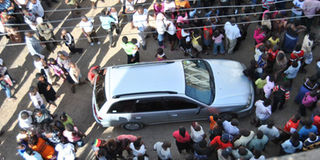Rift Valley tops crime statistics

PHOTO | ANTHONY OMUYA | FILE Residents look at a car used by three gangsters who were shot dead by police during a robbery bid in Kariobangi South, Nairobi, on April 30.
What you need to know:
- Most crimes reported in Rift Valley and Central
- North Eastern has the lowest incidents of crime at 454
- The report states that the police has increased its presence in crime prone areas in order to fight insecurity
Rift Valley is the most dangerous province to live in this year, according to the latest crime statistics released by the Kenya Police Service on Wednesday.
According to the data, 7,598 crimes were reported in the vast region between January and May this year, almost double the 4,450 crimes reported in Central, the second most dangerous province to live in.
The figures, however, indicate that the crime rate across the country over the first five months of this year has dropped compared to the same period over the last two years. So far, the country has recorded 30,285 between January and May, compared to 33,538 and 31,055 over the same period in 2012 and 2011, respectively.
“The trend shows in the year 2011-2012 there was an increase of 2,483 cases or 8 per cent in reported cases. In 2012-2013, crime decreased by 3,253 cases or 10 per cent in reported cases,” the report says.
The report states that there has been an increase in robbery and homicide even though there has been a decline in economic crimes, consumption of dangerous drugs, motor vehicle theft, criminal damage, theft of stock and offences against morality.
But in an interesting twist, Western and North Eastern provinces which have witnessed violent attacks by suspected militias are the two provinces with the lowest crime figures in the country over the last five months.
The report shows that Western has recorded 2,923 with Eastern (4,279), Nairobi (3,765), Coast (3,658) and Nyanza (3,061).
North Eastern has the lowest incidents of crime at 454 despite the grenade attacks witnessed in Mandera, Garissa and Mandera counties in recent weeks.
Police attribute the crimes to organised criminal groups and gangs, cattle rustling, proliferation of small arms and light weapons especially from war-torn countries as well as inter-tribal and clan clashes manifested in retaliatory attacks by armed militias.
They also cite urbanisation and population growth, economic conditions, poverty level and lack of job opportunities and cultural factors and educational, recreational and religious characteristics.
The report states that the police has increased its presence in crime prone areas in order to fight insecurity.
It has also established security posts which are meant for wider coverage of the area in the form of police patrols and prompt attention to distress calls whenever alarms are raised while also providing members of the public with mobile numbers they can call to report crime.




